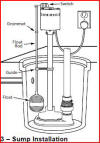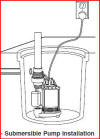Sump pumps are installed to protect your home from high ground water levels. They are usually installed in a sump basin that has holes in the bottom and sides to allow water to enter. The sump pump will then discharge the water from the basin when the float reaches a specific height.
Tools You May Require
- Adjustable wrench
- Pipe wrench
- Screw drivers
- Wet dry vac
The are two types of sumps available:
Pillar Type Sump
Motor is above the sump basin and float travel is adjustable.  Submersible type pump
Submersible type pump
Motor is sealed inside the housing and the float usually has a fixed amount of travel. 
Maintenance
 Sump pumps are something most homeowners pay little attention to; until it’s to late, and there’s several inches of water in basement. At least every few months you should check your sump pump and floats for proper operation and freedom of movement.
Sump pumps are something most homeowners pay little attention to; until it’s to late, and there’s several inches of water in basement. At least every few months you should check your sump pump and floats for proper operation and freedom of movement.
- The easiest way to check for proper operation is to lift up on the float to see if the pump turns on, or fill the sump basin with a hose or bucket.
- Annually unplug and remove the pump and check the condition of the housing, impeller and sump basin.
Replacing Your Sump Pump
- Always unplug the sump from the receptacle before working on it.
- When replacement is necessary try to purchase a similar pump with the same discharge size, voltage and horse power. This information can be found on your old pump’s motor plate.
- Disconnect the discharge pipe at the check valve and pull the pump out of the sump.
- Inspect the piping, check valve and adapter for overall condition if you plan to reuse them.
- Remove the pipe by unthreading the adapter from the pump.
- Using a wet dry vacuum clean out the bottom of the sump basin and inspect it’s condition.
- Unpack your new pump and remove any packaging ties holding wires and floats.
- Thread the adapter into the new pump and lower into the sump basin.
- Reconnect the pipe to the check valve and ensure the float has free travel in the sump basin.
- Plug in the pump and test it out.
